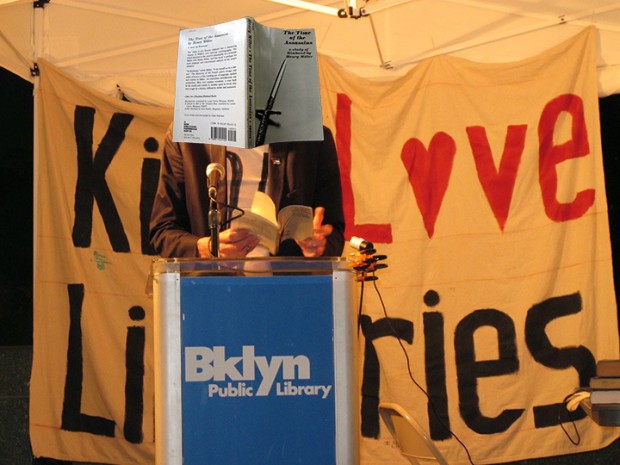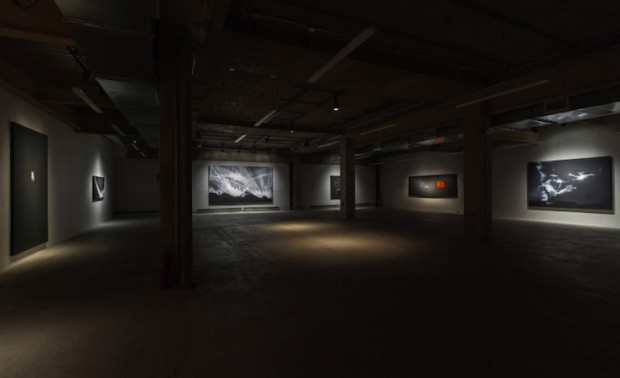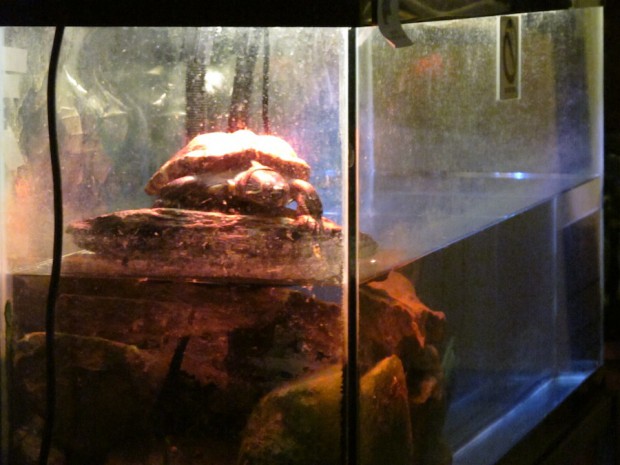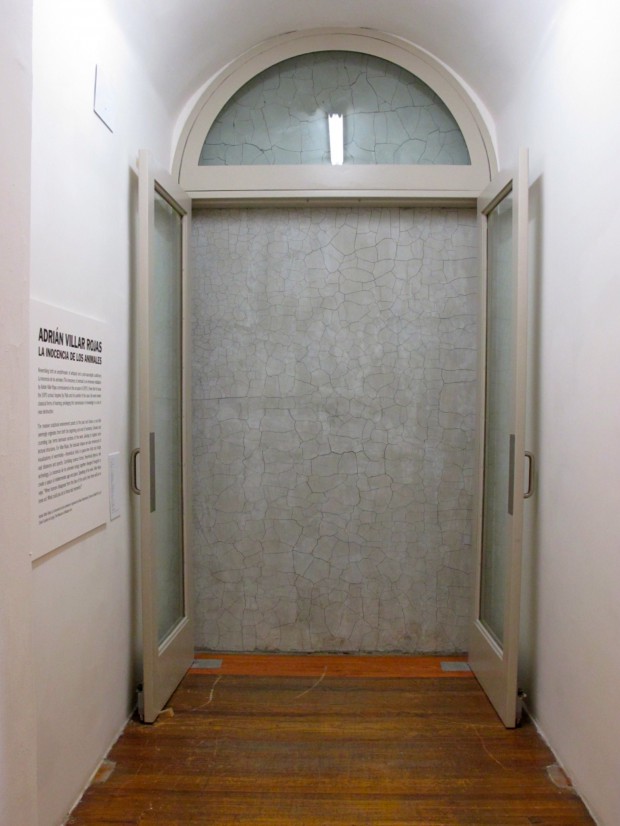1. Brooklyn Central Library, 24 Hour Read-In, 4:15-4:30am, Sunday, June 9

NYPL Read-In, photograph by Suzy Hernandez with alteration by author.
This month, I read in front of the Brooklyn Public Library as a part of the annual 24-Hour Read-In. As I listened to other readers, the topic for this second Pentagram Ecology column for Art F City came to mind: an examination of late night/early morning perception of artworks.
Those of us that keep gallery and museum working hours have difficulty seeing art shows that are not in the immediate vicinity of our places of employment. The festivities of evening art openings and the rushed pace of gallery visits during lunch breaks make careful looking difficult. As an MFA student at CalArts I observed that art production in the studios was most active between 10pm and 2am, and anecdotally, it seems that these working hours are favored by the majority of artists and writers that I know. Intuitively, daytime is less conducive to heightened perceptual and intellectual activity, so why does there exist a disconnect between production hours and exhibition hours? The project of identifying a nocturnal phenomenology is driven by the desire to bring cultural programming into harmony with human physiology.
2. Some 24 Hour Works of Art

Installation view from Where is Jack Goldstein?, photograph appears courtesy of Venus Over Manhattan
Yves Klein once proposed an artwork that would have placed speakers at regular increments on Manhattan rooftops for the sole purpose of amplifying an anguished scream throughout the city every morning at precisely 4am. This unrealized project recognized the existential drift of the late night mind and suggested a cathartic program for New Yorkers to participate in a communal release.
24 Hour Psycho by Douglas Gordon and The Clock by Christian Marclay are both widely popular video works that, by fact of their form, force exhibiting institutions to consider deviation from normal viewing hours. In Point Omega, a novel by Don DeLillo, the desire for continuous exhibition is well expressed by the protagonist viewing Douglas Gordon’s 24 Hour Psycho:
“Twenty-four hours. The museum closed at five-thirty most days. What he wanted was a situation in which the museum closed, but the gallery did not. He wanted to see the film screened start to finish over twenty-four consecutive hours. No one allowed to enter once the screening begins….He wanted complete immersion, whatever that means. Then he realized what it means. He wanted the film to move even more slowly, requiring deeper involvement of eye and mind, always that, the thing he sees tunneling into the blood, into dense sensation, sharing consciousness with him.”
In a more institutionally confrontational and philosophically direct artwork, the late Michael Asher highlighted the psychotemporal reception of artworks in his No Title contribution to the 2010 Whitney Biennial. There, he proposed that the Biennial remain open to the public all day and night for one week. Negotiations between institutional concerns and the integrity of the piece resulted in a compromise; the artwork would be open from Wednesday, May 26th at 12am through Friday, May 28th at 11:59pm. I attended the museum from 3 – 5am on that Thursday morning. During my late night visit I noticed that the museum employees and visitors were much more conversational with each other and viewers seemed to spend more time looking at the individual artworks than during my daytime trips to the Biennial.
Curatorial decisions made for the recent Jack Goldstein show at Venus Over Manhattan successfully undermined the conventional separation between late night studio atmospherics for production and bright white gallery boxes for exhibition. The effect of darkening the space, installing the paintings on unfinished drywall, and playing the mournful Patsy Cline songs that Goldstein favored in his studio, was that the exhibition took on the late night intimacy of a séance. While gallery hours went unchanged, the vibe was pure midnight, which created an altered perceptual state for the painting and video work on display.
3. A Suggested Stimulant

Khat, photograph by author
Khat, Catha edulis, is a flowering plant with leaves that contain a monoamine alkaloid stimulant. Khat is indigenous to East Africa and Arabian Peninsula and has gained a behind the counter presence in Yemeni owned New York City delis. If one is familiar with the owner, a bag can be obtained, and a cheek full of leaves will boost energy and attention for intrepid late night art excursions.
4. A Case Study

Turtle as seen through the window of Mary McDowell Friends School, photograph by author
Up one of these hot summer nights looking for an art fix, I aimlessly walked from my Prospect Heights apartment toward Manhattan. At 3:30am I reached Brooklyn Heights and passed by the curious window display at the Mary McDowell Friends School.
The storefront window sill exhibits wonky architectural models of the Chrysler Building and several NYC bridges, while further back in the room, a turtle struggled to scale the rocks in a harshly illuminated aquarium.
The turtle’s journey toward the light bulb was excruciating to observe. Its webbed feet slid on the rocks. Half an hour passed before the turtle reached the pinnacle. The turtle angled its head in alignment with the bulb, then elongated its neck to draw as near to the light as possible. It held the position still for a moment, then turned and slid down the rocks back into the water.
In a city without regularly scheduled nighttime exhibitions, the working man insomniac, seeking art experiences, makes the accessible world a gallery. Graffiti, outdoor sculpture, LaMonte Young’s Dream House, derelict window displays, abandoned buildings, and interactions with other late night denizens all take on heightened aesthetic significance when the din of the day is hushed and the crowds have abandoned the streets. Parts of the city become isolated out of time and mundane events take on a relation to meaning that might be unconsidered in the heat and bustle of the summer’s day.
“A well known scientist (some say it was Bertrand Russell) once gave a public lecture on astronomy. He described how the earth orbits around the sun and how the sun, in turn, orbits around the center of a vast collection of stars called our galaxy. At the end of the lecture, a little old lady at the back of the room got up and said: “What you have told us is rubbish. The world is really a flat plate supported on the back of a giant tortoise” The scientist gave a superior smile before replying, “What is the tortoise standing on?” “You are very clever, young man, very clever,” said the old lady. “But it’s turtles all the way down!” Stephen Hawking, A Brief History of Time
5. In Praise of Aimlessness

Detail from La inocencia de los animales, photograph by author
“…nihilism is overcome through a transvaluation whereby the pointlessness of becoming is embraced beyond its opposition to the supposed purposefulness of true being—aimlessness is affirmed in and for itself, without appeal to extrinsic justification. Thus the affirmation of eternal recurrence marks the coincidence of ‘midday and midnight’ it is at once the apex of of affirmativeness—the eternalization of transience—and the nadir of negativity—the negation of all purposiveness.”— Ray Brassier, Nihil Unbound
Brassier’s praise of aimlessness erases the demarcations of day and night. Any thought, aesthetic or otherwise, must be in motion for its own sake, in order to escape the cliches of nihilistic despair. The mind’s travel must be allowed to go everywhere all of the time.
Common sense meanings or existential quandaries that could be assigned to the turtle’s caged climb or the flaneur’s aleatory walk are upended. Aimlessness seeks access. In developing a nocturnal phenomenology, artists and exhibiting institutions would be responsible to consider the 24-hour mind, and disregard the banker’s hours that are habit in the city.
On Friday, July 19 Raymond Brassier will speculate on the future at PS1 as Part of Expo1: NewYork at the EXPO school (entrance pictured above). The lecture hall is an installation designed by Adrián Villar Rojas and titled La inocencia de los animales.


Comments on this entry are closed.